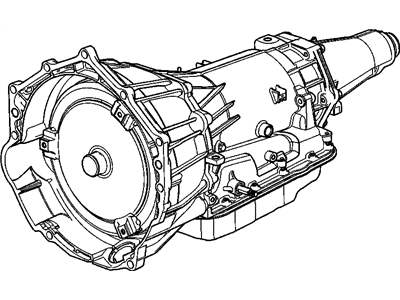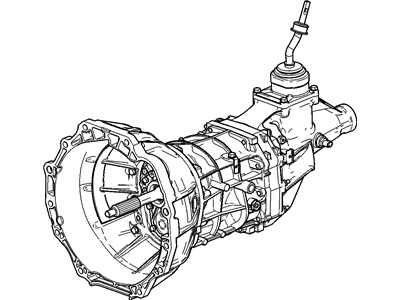
My Garage
My Account
Cart
Genuine GMC Canyon Transmission Assembly
Trans Assembly- Select Vehicle by Model
- Select Vehicle by VIN
Select Vehicle by Model
orMake
Model
Year
Select Vehicle by VIN
For the most accurate results, select vehicle by your VIN (Vehicle Identification Number).
50 Transmission Assemblies found
GMC Canyon TRANSMISSION ASM,AUTO 18BUA (SERV REMAN)
Part Number: 19419944$3670.10 MSRP: $4104.19You Save: $434.09 (11%)GMC Canyon Transmission, Auto (Service)
Part Number: 17803774$3084.50 MSRP: $3472.63You Save: $388.13 (12%)GMC Canyon Transmission, Auto (Service)
Part Number: 89037507$3193.28 MSRP: $3595.67You Save: $402.39 (12%)Ships in 1-3 Business DaysGMC Canyon Transmission Assembly, Auto (1Bna)
Part Number: 24291516$3089.67 MSRP: $3447.58You Save: $357.91 (11%)Ships in 1-3 Business DaysGMC Canyon Transmission Assembly, Auto(0Tgl)
Part Number: 24286981$4945.60 MSRP: $5475.79You Save: $530.19 (10%)Ships in 1-3 Business DaysGMC Canyon Transmission Assembly, Auto(0Thl)
Part Number: 24286982$4372.84 MSRP: $4827.87You Save: $455.03 (10%)Ships in 1-3 Business DaysGMC Canyon Transmission Asm,Auto (1Tsd Goodwrench Remanufacture)
Part Number: 17803876$3080.90 MSRP: $3468.55You Save: $387.65 (12%)Ships in 1-3 Business DaysGMC Canyon Transmission Assembly, Auto (1Bua)
Part Number: 24291518$2485.48 MSRP: $2764.11You Save: $278.63 (11%)Ships in 1-3 Business DaysGMC Canyon Transmission Asm,Auto (2Tsd Goodwrench Remanufacture)
Part Number: 19299341$2798.40 MSRP: $3148.99You Save: $350.59 (12%)Ships in 1-3 Business DaysGMC Canyon TRANSMISSION ASM,AUTO 18BMA (SERV REMAN)
Part Number: 19419947$4002.95 MSRP: $4480.71You Save: $477.76 (11%)Ships in 1-3 Business DaysGMC Canyon Transmission Asm,Auto (1Ttd Goodwrench Remanufacture)
Part Number: 17803850$3081.95 MSRP: $3469.74You Save: $387.79 (12%)Ships in 1-3 Business DaysGMC Canyon TRANSMISSION ASM,AUTO 5BSA (SERVICE REMAN)
Part Number: 19333278$3811.70 MSRP: $4288.13You Save: $476.43 (12%)Ships in 1-3 Business DaysGMC Canyon Transmission Asm,Man
Part Number: 24284719$2804.40 MSRP: $3172.40You Save: $368.00 (12%)Ships in 1-3 Business DaysGMC Canyon Transmission Asm,Auto (1std Goodwrench Remanufacture)
Part Number: 17803811$3082.20 MSRP: $3470.03You Save: $387.83 (12%)Ships in 1-3 Business DaysGMC Canyon Transmission Asm,Auto (Service Remanufacture)
Part Number: 19299339$2794.06 MSRP: $3144.08You Save: $350.02 (12%)Ships in 1-3 Business DaysGMC Canyon Transmission Assembly, Man
Part Number: 24287050$4406.56 MSRP: $4984.81You Save: $578.25 (12%)Ships in 1-3 Business DaysGMC Canyon TRANSMISSION ASM,AUTO (REMAN)
Part Number: 19433332$4933.67 MSRP: $5486.05You Save: $552.38 (11%)GMC Canyon TRANSMISSION ASM,AUTO (REMAN)
Part Number: 19433349$4975.48 MSRP: $5533.35You Save: $557.87 (11%)GMC Canyon TRANSMISSION ASM,AUTO (REMAN)
Part Number: 19433341$5223.55 MSRP: $5837.73You Save: $614.18 (11%)
| Page 1 of 3 |Next >
1-20 of 50 Results
GMC Canyon Transmission Assembly
Each OEM GMC Canyon Transmission Assembly we offer is competitively priced and comes with the assurance of the manufacturer's warranty for the part. Furthermore, we guarantee the speedy delivery of your orders right to your doorstep. Our hassle-free return policy is also in place for your peace of mind.
GMC Canyon Transmission Assembly Parts Questions & Experts Answers
- Q: Is replacing a manual transmission assembly a challenging task for a do-it-yourselfer on GMC Canyon?A:Changing a manual transmission can by and of itself be a do it yourselfer's nightmare in that as mentioned above many small parts need to be removed and replaced and the clearances have to be measured and in most cars, when these clearances are not correct, select fit spacers and snap rings are used. Though, a competent do-ityourselfer can do the removal and installment if arises, the overhaul is better left to a transmission repair shop since undertaking it times and costs more compared to a rebuilt type, which can be sourced from dealer's parts and auto part stores. A novice can rebuild a transmission if he/she has the right special tools, and plans the job in a step by step manner so as not to miss any step. Some of the tools that recommend themselves during the overhaul are the internal and external snap ring plier, the bearing puller, the slide hammer, the set of pin punches, the dial indicator and hydraulic press, the big and solid working bench and the vise or the transmission stand. It is especially important to document disassembly, including how a particular part was taken out and the orientation and methods of joining of that part to the others. Another way in which it is possible to get an understanding of specific issues is to have an understanding of a particular malfunctioning area of the transmission before disassembly has been accomplished, because this also makes certain issues more distinct during the examination and replacement of components.
Related GMC Canyon Parts
Browse by Year
2024 Transmission Assembly 2023 Transmission Assembly 2022 Transmission Assembly 2021 Transmission Assembly 2020 Transmission Assembly 2019 Transmission Assembly 2018 Transmission Assembly 2017 Transmission Assembly 2016 Transmission Assembly 2015 Transmission Assembly 2012 Transmission Assembly 2011 Transmission Assembly 2010 Transmission Assembly 2009 Transmission Assembly 2008 Transmission Assembly 2007 Transmission Assembly 2006 Transmission Assembly 2005 Transmission Assembly 2004 Transmission Assembly








